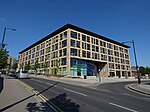St John the Baptist's Church, Wakefield, West Yorkshire
1795 establishments in EnglandChurch of England church buildings in West YorkshireChurches in Wakefield, West YorkshireGrade II* listed churches in West YorkshireListed buildings in Wakefield ... and 1 more
Use British English from May 2020

The Church of Saint John the Baptist in Wakefield, West Yorkshire, England is an active Anglican parish church in the archdeaconry of Wakefield and the Diocese of Wakefield. The church is Grade II* listed and has been since 30 March 1971. St John's is the smaller of the Anglican churches in Wakefield City Centre, the larger being Wakefield Cathedral.
Excerpt from the Wikipedia article St John the Baptist's Church, Wakefield, West Yorkshire (License: CC BY-SA 3.0, Authors, Images).St John the Baptist's Church, Wakefield, West Yorkshire
Wentworth Street, Wakefield
Geographical coordinates (GPS) Address External links Nearby Places Show on map
Geographical coordinates (GPS)
| Latitude | Longitude |
|---|---|
| N 53.6884 ° | E -1.5055 ° |
Address
St John's Church
Wentworth Street
WF1 2RD Wakefield
England, United Kingdom
Open on Google Maps











